


The term, 'The Son of Gentlefolk', was used to describe the background of young men indentured to the P&O Steam Navigation Company in the 19th Century.
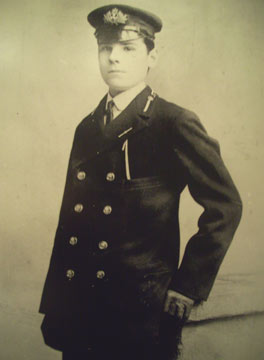
Conway Cadet Walter Hiscock RNR ~ 1911
Why it seems as if many a sun hadn't set;
Since the old Dad called me his smart cadet;
And I see the tear in my mother's eye,
As she kissed and kissed me, and sobbed good bye.
Aliph Cheem ~ Lays of Ind. 1871
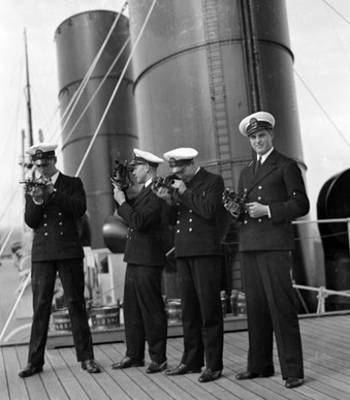
Deck Officer Cadets 'shooting the Sun' aboard Viceroy of India in the 1930s
"The P&O has its own standards, which are higher than the average. It therefore offers to officers in all departments, conditions better than those applied to the industry as a whole. This has been true in bad times as well as in good, and will, we hope, remain true."
From Regulations, Instructions & Advice for Officers of the Peninsular & Oriental Steam Navigation Company ~ c1959
For many years, the Company recruited its Deck Officer Cadets exclusively from the three public school nautical colleges, Worcester, Conway and Pangbourne. Latterly, Cadets were accepted from Gordonstoun and The School of Navigation, Warsash. Life aboard the cadet training ships Worcester and Conway would be considered harsh when judged by today's standards.
"My introduction to the ship was in error on my first day. It was April 1950. Wearing my brand new uniform I and a group of other cadets were taken from the shoreside causeway in a large motorised boat. On arrival at the ship side, two gangways led upwards. A queue formed to climb one of them. I chose the other, quite deserted. Big mistake, for that gangway was reserved for the captain and senior officers! A form of punishment followed of course. For two years I was ill fed (rationing was still in force), regularly beaten by cadet captains for some small misdeed or other (a minority were sadistic bullies), scrubbed wooden decks until they shone, and made to climb the rigging of the 3 masted Worcester, (and the Cutty Sark’s which floated alongside). All with no safety nets! As the ship was a recognised small public school, and a paying one at that, many a doting parent sweated over the demand for fees to pay for all this." By Richard Danielson - Sea Breezes
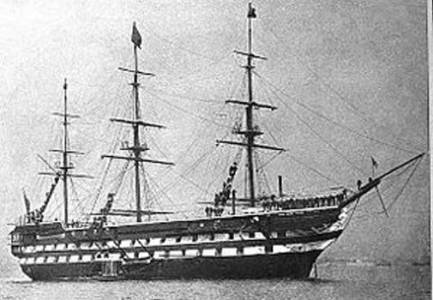
Worcester Conway
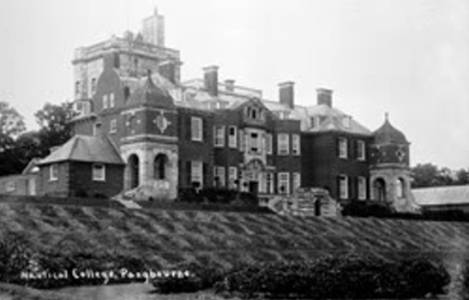
Pangbourne
Worcester
"In early September, 1914 I found myself alone on the deck of HMS Worcester, moored in the Thames off Greenhithe. Anyway, I seemed to be alone, although the deck was swarming with Cadets, some brand new like myself, others obviously old hands by their jaunty air and by the way they mixed with their particular pals as they discovered them, back from the summer holidays. Boatloads of new arrivals constantly clattered up the gangway, saluted smartly and rattled away with their suitcases into the lower decks. In my brass-buttoned uniform, my peaked cap with its white cover and shiny new badge, I felt horribly conspicuous especially after the drab school clothes more common to my days at elementary school." Donald Macfadyen.
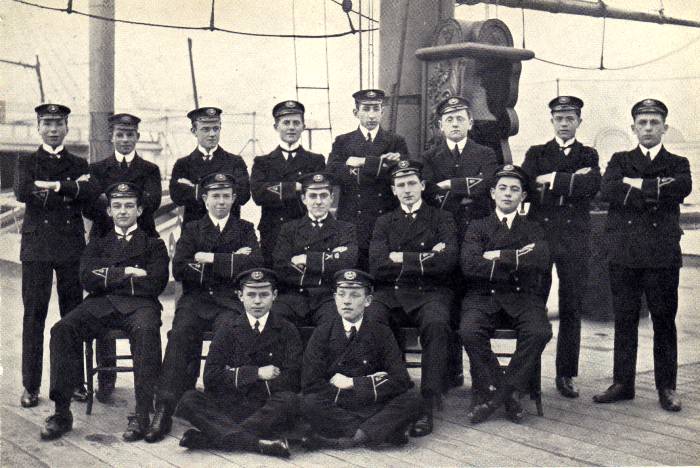
Worcester Cadet Captains, 1913. D. G. Baillie, a future P&O Commodore, is second from left in the back row.
"Sanitation was somewhat primitive, the ‘heads’ being best described as short galleries overhanging the water at the base of the bowsprit on each bow. We slept in canvas hammocks on the lower deck, being divided into ‘tops’, usually in accordance with seniority but sometimes according to physical size. This latter reason was simply to provide a squad of hefty youngsters, not novices, who could be called on suddenly simply by piping ‘foc’slemen muster on the upper deck’." Donald Macfadyen.
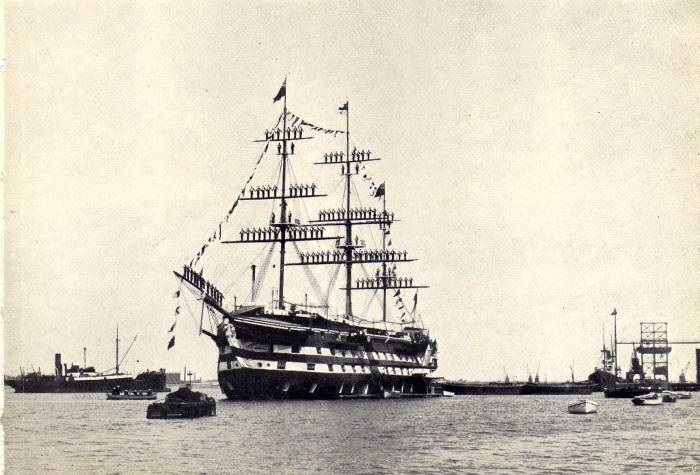
Worcester cadets manning the yards, Founders Day 1913
"First termers (known by an opprobrious and unprintable name) formed the afterguard. Second and third termers probably graduated to the mizzen top. The fourth term lifted you from the social slough of a new cadet into the intoxicating delights of the ‘old hand’. No longer could you be fagged; you could with impunity answer back another ‘old hand’ without incurring a cut from a ‘bimster’, and – oh scrumptious bliss! You could ‘fag’ a new boy to carry your football boots to the field or to some such menial task. Moreover you were lifted from physical contact with the kids in the mizzen top or afterguard by being promoted to sling your hammock with the main or foretopmen or even (if you were hefty) with the Olympian gods in the foc’sle." Donald Macfadyen.
"P. and O. scholarships deserve special mention as being the first of many introduced by shipping companies, City of London Livery Companies and Societies, for assisting boys to go to sea. Scholarships now comprise a separate chapter in the Worcester Prospectus, and the P. and O. scheme lasted for twenty-five years, over two hundred cadets taking advantage of it. Among them was the writer, (Gordon Steele) who joined the Worcester with the first batch of candidates in 1907; in the same group was Lieutenant-Commander G. E. G. Sandercock, R.N.R., who won the King's Gold Medal in his last term, and subsequently served in the Suez Canal Pilot Service, rising to senior pilot before retiring. Another distinguished officer in this first batch of thirteen cadets was the late Commodore Jeffrey Elliott, D.S.O., R.D., R.N.R., who rose rapidly to Assistant Marine Superintendent of the P. and O. Line. Joining the Royal Navy at the beginning of the last war, he served with distinction, finally losing his life as Commodore of an ocean convoy. Many equally distinguished P. and O. cadets have followed them down the years."
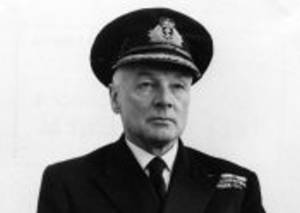
The Story of The Worcester ~ Commander Gordon Steele, VC, RN, 1962
Captain Superintendent 1929-1957
During his time in the Worcester he was considered a brilliant student, winning the Howard Medal for Meteorology, and coming second for the Kings Medal of 1909. Indentured to the P&O, he joined his first ship, the Palma, a twin-funnelled passenger liner, completing his cadetship, some three years later, in the Egypt. At the outbreak of the First World War, he was serving as Third Officer in the Caledonia. Mobilized as an RNR Officer, he was one of the first reservists to serve in submarines.
Lieutenant-commander G. C. Steele, V.C., R.N., was appointed Captain-Superintendent on August 1st 1929. The Admiralty had agreed to place him on half-pay for two years as he was under the age for normal retirement. He was a cadet in 1907-9 under Captain Wilson-Barker, and served his apprenticeship in the P. and O. Line. He rose to Third Officer in charge of a watch before he joined the Navy in 1914 for the First World War as Sub-Lieutenant R.N.R. He was transferred to the Royal Navy in 1915 as a reward for distinguished service in action in sinking a U-boat when he was Gunnery Officer of the first Q-ship. After serving in submarines he joined H.M.S. Royal Oak and was present at the battle of Jutland. He obtained his first command, P C 56, an ocean escort vessel, at the age of twenty-five, and ended the War in command of the sloop H.M.S. Cornflower in the Eastern Mediterranean. He won his VC in 1919 against the Bolsheviks at Krondstadt.
"For most.
conspicuous gallantry,
skill and devotion to duty on the occasion of the attack on
The
When he returned to England he specialized in anti-submarine duties, and was serving as First Lieutenant-Commander of H.M.S. Cornwall on the China Station when he took command of the Worcester.
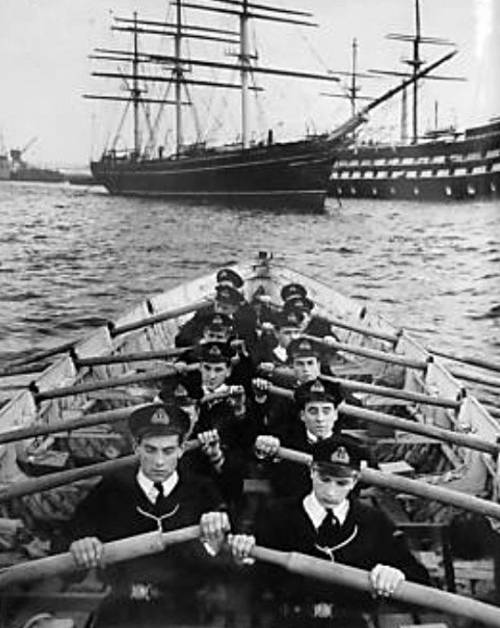
Cutter's Crew, Pulling towards Cutty Sark & Worcester
'........those who came successfully through the Worcester mill were tough little beasts, ready for plenty of hard work and strict discipline.'
"I am reported to have a good grasp of Signalling (Flags, Semaphore, Morse and Aetheric), and have been instructed in the Elements of Hygiene and Care of the Sick and Injured on board ship. Compared with the knowledge required of a cadet today, all this sounds both elementary and archaic; it has a decidedly tarry, Nelsonic flavour about it. Yet the date on the certificate is only 1913, the Early Victorian-looking cadet wears a uniform exactly like mine, and indeed, to judge from an old photograph, his appearance resembles mine quite closely.
At the bottom of the certificate is an earnest little exhortation to the Holder particularly requesting him to correspond with the Captain or Head Master whilst abroad on all professional topics, Notes on Tides, Currents and Pilotage, the Manners, Customs, Productions and Commerce of Countries he may visit, Accidents at Sea, Plans adopted in Emergencies and Unknown Dangers. These communications would be acknowledged and registered in the Worcester Record Book and 'will tend to the instruction and amusement of the Pupils on board. It should be the desire of every Pupil to have such a creditable addition to his page'.Commodore D. G. Baillie - A Sea Affair
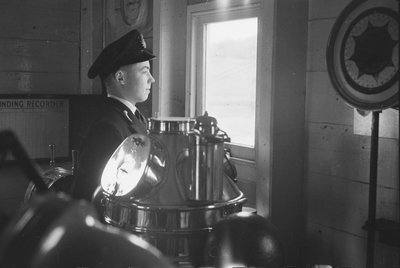
I see no ships....only hardships....
"I regret to say that I never responded to this admirable invitation, neither have I ever returned to the Worcester, although I have promised myself many a time that I would do so, for once I had become used to the hardships and the disagreeable tasks inseparable from any place where you are being taught and disciplined, I had grown to love the great water highway of the Thames running past our very gangway, and had developed quite an affection for the old ship and the life aboard her. At least we had learnt hardihood and self-reliance during our two years' training, for those who came successfully through the Worcester mill were tough little beasts, ready for plenty of hard work and strict discipline. Expecting little from life, we were agreeably surprised if it gave us anything at all in return for the endeavour and the concentrated attention to duty which we were prepared to put into it. We certainly did not consider ourselves entitled to the comforts and advantages which are regarded as necessities by the young apprentice of today.
The next stage in the proceedings was the vitally important one of going to sea; and strange to say, now that I had reached the threshold of my career and the actual step was irrevocable, I began to wish that I had picked for my trade something a little less adventurous, something which did not entail quite such a drastic break with family and home, or the striking out for myself into a world so very unfamiliar and formidable." Commodore D. G. Baillie - A Sea Affair
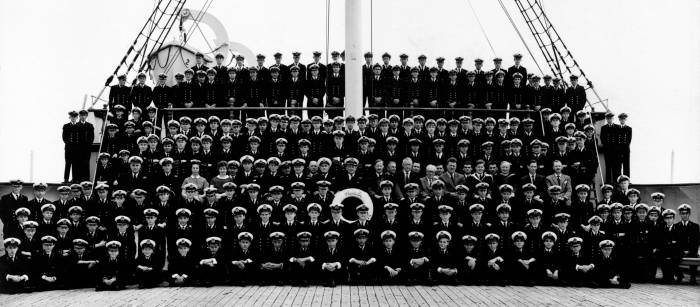
Worcester Ship's Company in 1963
Link to Colin Thurlow's Worcester website: http://www.hms-worcester.me.uk/index.html
Link to Association of Old Worcesters Website: http://www.hms-worcester.org.uk/
Link to Nick Messinger's Worcester Website: http://www.nickmessinger.co.uk/worcester.html
Conway
The average time spent aboard by Conway cadets was two or three years, with entry between the ages of 12 and 15. Eminent cadets included John Masefield (1891-1953) who wrote the Conway's history in 1933 and again in 1953; Captain Matthew Webb, the first man to swim the channel in 1875; and Kenneth Shoesmith, marine artist (d.1939), as well as many eminent ship's captains.
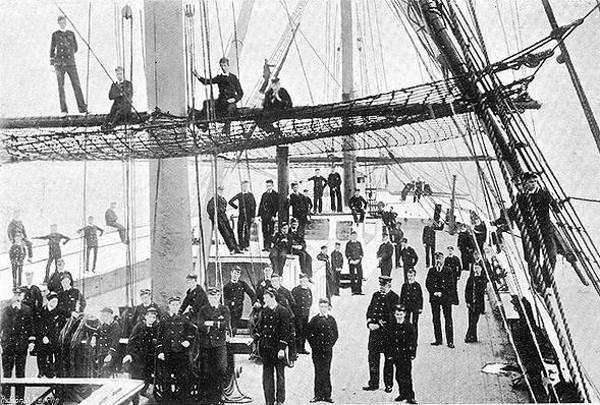
Conway Cadets on the ship's upper deck around 1900
The 19th century had seen tremendous expansion in foreign trade and, in consequence, a rapid growth in the numbers and size of deep-sea ships which were carrying increasing numbers of passengers and emigrants in addition to valuable cargoes. The greater values at risk and the increasing sophistication of the vessels demanded more advanced skills of those who were to officer and command them. Thus the first Merchant Shipping Act was introduced in 1851, closely followed by another in 1854. Among other matters, these Acts required that deep-sea ships be commanded by certificated personnel who were to be examined for their competence. As a result, a number of ship-owner associations were formed to provide the necessary training and education, including one in Liverpool. They asked the Admiralty for a suitable ship on which to train, and received an old frigate, HMS Conway, which was put into service as a school-ship in 1859.
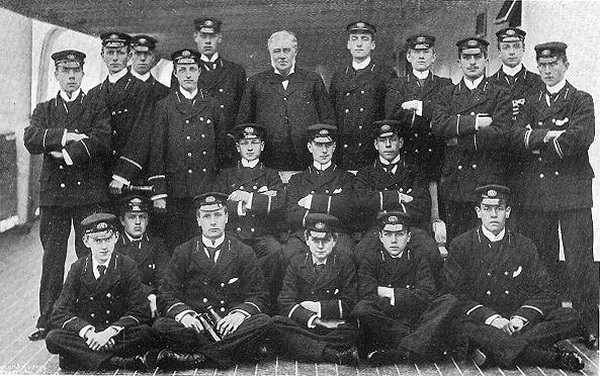
Captain Miller and Conway Cadet Captains in June 1897
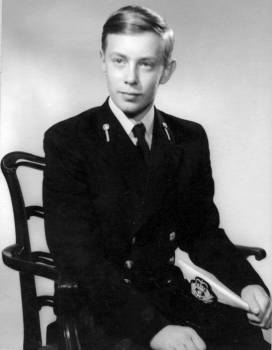
Cadet Richard Collinson ~ First Term at Conway
Link to Conway Website:-
Pangbourne
The Nautical College Pangbourne was founded by Thomas Lane Devitt in 1917 with the purpose of preparing boys to be Officers in Merchant Navy aboard ships of the Devitt and Moore shipping company. through the shipping company. In 1969 the College became 'Pangbourne College', in a move that saw a shift in focus to the provision of a traditional academic programme. Many of the founding traditions of the College continue to reinforce the values that lie at the core of the College today. Unlike Worcester and Conway, Pangbourne College continues to thrive, having kept pace with the challenging demands of the 21st Century.
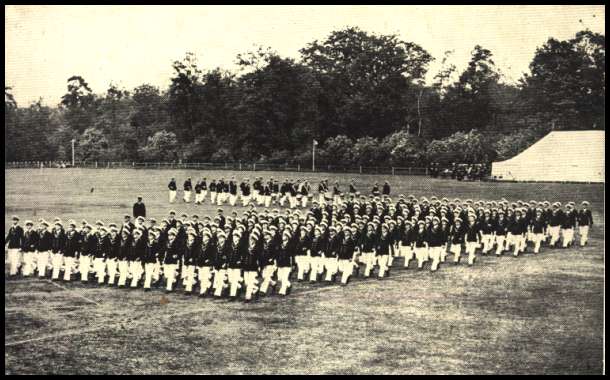
Pangbourne Founders Day Parade, 1930
"My first contact with Pangbourne College was in early 1933. Having been accepted for entry as a Cadet Royal Naval Reserve from my preparatory school in Kent, I was visited at home in Bournemouth by a Mr. Kingston from Gieves in London to measure me for my uniform. At some stage after that I sat for the scholarship examination. There was an infectious disease at the College at the time and the five of us involved took the exam at the St. Ives hotel close to what is now the College boathouse by the Thames - where later I received a Bronze medallion for collecting a brick from the bottom of the river!. I got an exhibition worth £35 a year. Forty of us joined the College on September 18, 1933. Seven were to be killed in action in the Second World War." Keith Evans, Old Pangbournian.
Link to Pangbourne College Website
http://www.pangbournecollege.com/
Warsash ~ School of Navigation
"In 1956, I bade school a hasty farewell and was packed off, bursting with pride in a splendid naval uniform with shiny brass buttons and cadet’s gorgets, to the School of Navigation at Warsash in Hampshire. Here 128 cadets in various stages of despair or grim determination were moulded, in a year, into something fit to go to sea without entirely disgracing themselves and their calling. Physically and mentally, it was an extremely tough time for any 16-year-old boy but ultimately rewarding. Having passed out of Warsash as a senior cadet captain, I was indentured to the P&O Steam Navigation Company as a cadet and joined my first ship in the Royal Docks at London on October 11, 1957. The training spanned more than three years in cargo ships and tankers under the guidance of the officers, bosuns and other poor souls who taught us how to become seamen." Michael Studholme Cavaghan
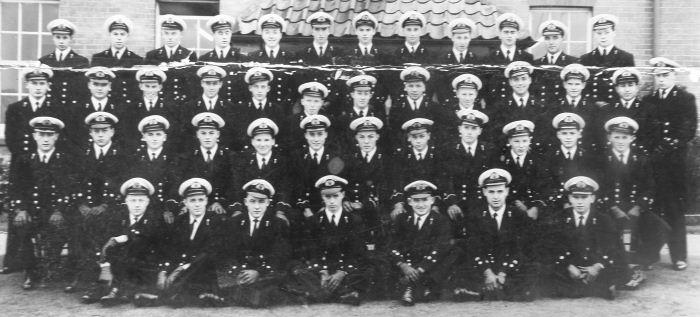
Warsash Cadets 1958
Today, Warsash Maritime Academy is one of the world's leading providers of education, training courses, research and consultancy services to the maritime industries.
http://www.warsashacademy.co.uk/home.aspx
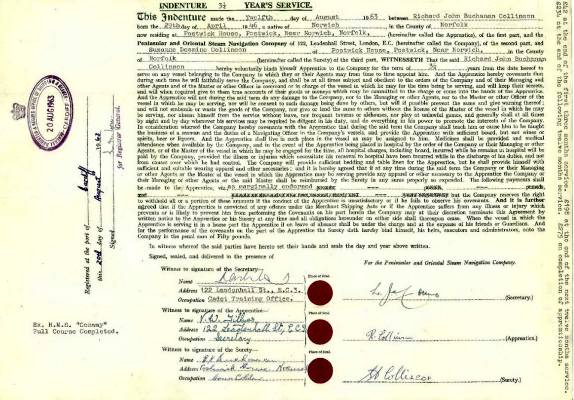
Cadet Richard Collinson's P&O 3¼ Years Indentures
Cadets signed indentures with the company, and served for 3 - 3¼ years aboard cargo and passenger ships of the P&O fleet, before obtaining the necessary sea-time for their Board of Trade Second Mates examinations. Merchant Navy cadets normally served a four year apprenticeship, but up to one years remission of sea time was granted to those who had passed their pre-sea school leaving certificate examination.
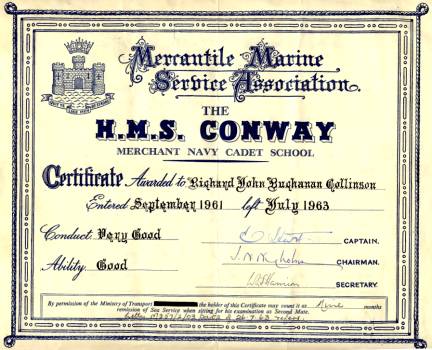
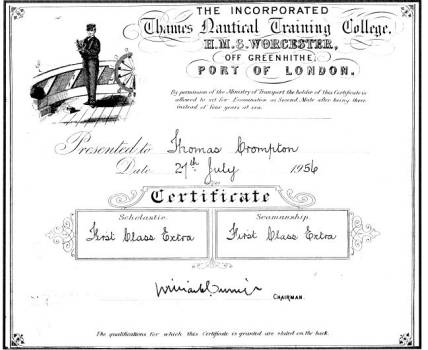
Cadet Richard Collinson's Conway Leaving Certificate Cadet Thomas Crompton's Worcester Leaving Certificate
Pay was minimal, parents and guardians having to provide a surety, plus uniforms, sextant and binoculars - and a monthly allowance, where this could be afforded. Study leave pay, in 1968, was just £44 per month, the same as that earned by a senior cadet while at sea. A 'bonus' of £30 being awarded to officers returning to the company, having obtained their Second Mates certificate.
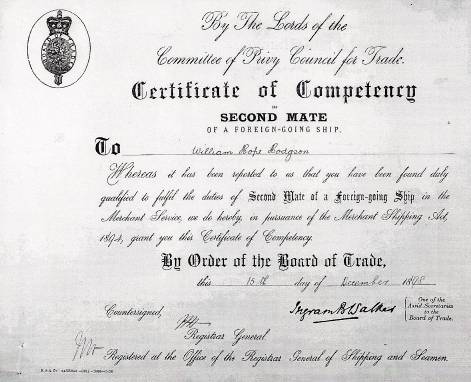
Warsash Cadets visiting ss Carthage at Southampton ~ c 1960
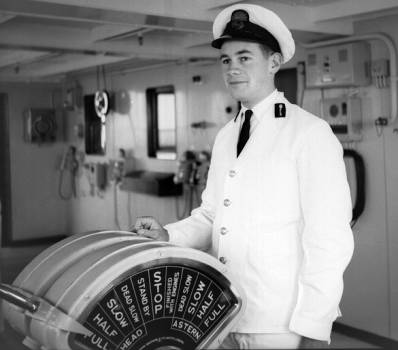
Cadet Ian Gibb, SS Iberia 1955 ~ Retiring as Commodore in 1996
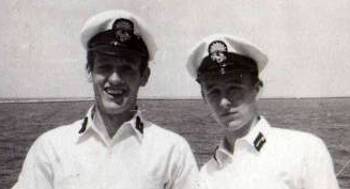
Cadets Nick Messinger and the late Paul Clark, ss Ballarat 1961
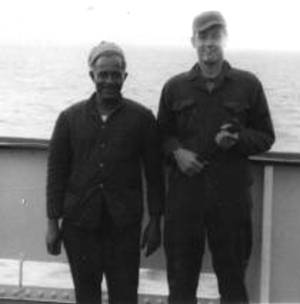
Serang and daywork Cadet Nick Messinger ~ ss Ballarat 1961
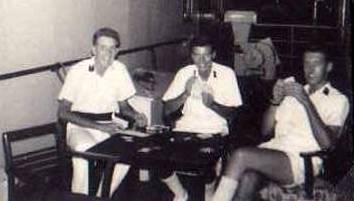
Cadets Jim Harwood (Pangbourne), Ted English (Conway) and Nick Messinger (Worcester) ~ off duty, playing cards on the boat deck ~ ss Ballarat 1961
Launch-driving duties were the greatest of fun for cadets. Seen here are Steve Asquith and Griffiths, ss Iberia 1963. Photo by: Peter Hull
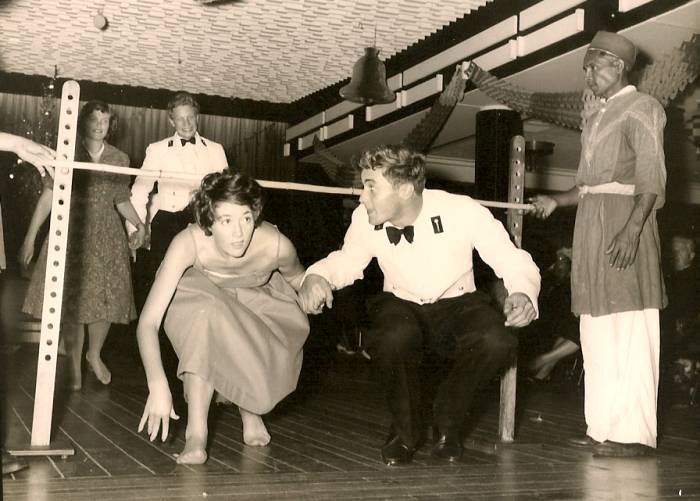
ss Iberia, Gala Night, 1962 ~ Cadets Steve Asquith and Peter Hull
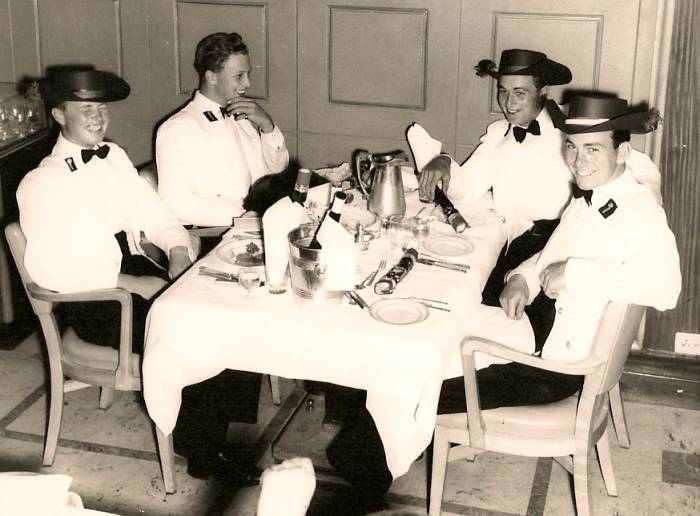
ss Iberia, Christmas Dinner 1962, Cadets Camp, Asquith, Hull and Griffiths
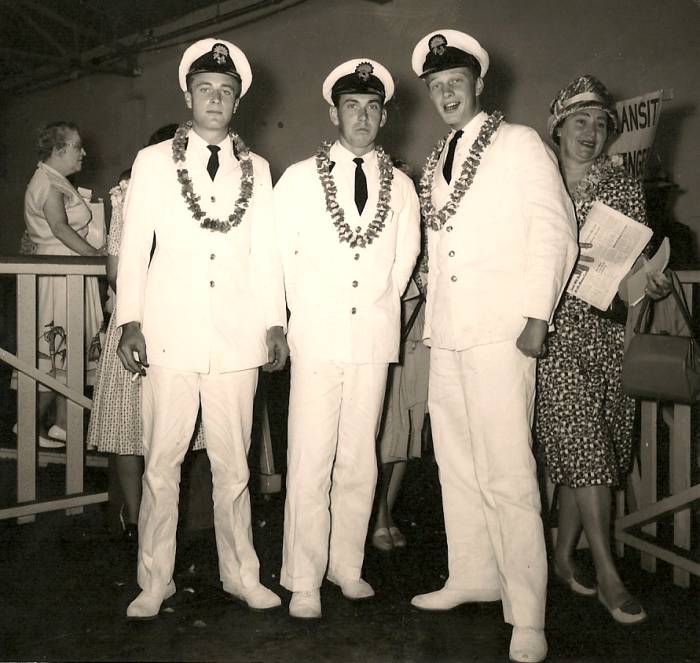
ss Iberia, Cadets Hull, Griffiths and Asquith at Honolulu 1962
Cadets on board ss Strathaird in July 1958,with Captain J.M.Perry ~ Photo Chris Upjohn via John Perry
Back Row: Perry, Upjohn, Wesson, Lane. 2nd Row From Back:Trousdale, unknown, Graham, Hicks, Willi, Marsland, Martin.
3rd Row From Back: Cadet Officer Davie, Chief Officer Cooke, Captain Perry, Staff Captain Cowen, Fist Officer Hansing, Turner
Front Row: Tinsley, Harrington, Allan, Wilkin
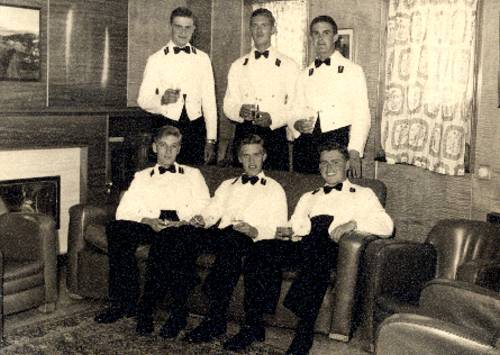
ss Arcadia's Cadets ~ Wardroom 1958
Back row: Willi, Porteous, Falkner ~ Front Row: Senior, Lane, Perry
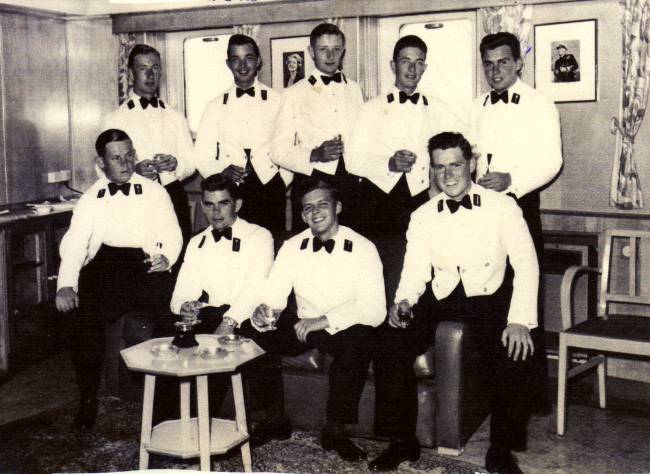
ss Iberia's Cadets ~ Wardroom 1957
Back Row: Goddard, Johns, Lucas, Peartree, Harrington ~ Front Row: Harvey, Ferguson, Davie, Perry
Lock up your daughters!
Many are the
thoughts of those P&O dream days,
these will be memories treasured for ever.
Bleached white is their hair now - salt still in their veins,
with memories of shipmates - now young forever...
Cadets off duty aboard ss Ballarat 1961 - Nick Messinger and the late CFLG (Colin) Evans. Colin was a great character and a brilliant shipmate - the former Chief Cadet Captain of Pangbourne - tragically to take his own life many years later. Photo by : Peter Hull.
Cadet Peter Hull - first trip aboard ss Sunda 1961
By way of a complete contrast.......
David Martin Rowden joined the P&O as a Deck Cadet in 1960, and spent his apprenticeship on the Company's cargo ships of which Pinjarra was his first. On board Salsette’ he experienced the joys of carrying over 200 buffalo and 300 individually lattice crated pigs (stacked 3 high on the hatch-covers) from Bangkok to Hong Kong. It was the job of the Cadets to feed and clean these animals out under the hot tropical sun armed only with a canvas fire hose and a broom. Particular attention needed to be paid to the pigs on the bottom tier. No matter how hard they scrubbed themselves in the showers, the Cadets were not allowed in the Officers Dining Room, but condemned to the Duty Engineers Mess for ten days.

Midshipmen, Royal Naval Reserve
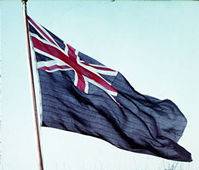
The Royal Naval Reserve was founded under the Naval Reserve Act in 1859 as a reserve of professional seamen from the Merchant Navy and fishing fleets, who could be called upon during times of war to serve in the regular Navy. The RNR was originally a reserve of seamen only but in 1862 this was extended to include recruitment and training of officers. In 1864 it was announced that a British merchant ship would be allowed to fly the Blue Ensign, providing that the ship's master was an officer of the RNR and the crew contained a specified number of reservists.
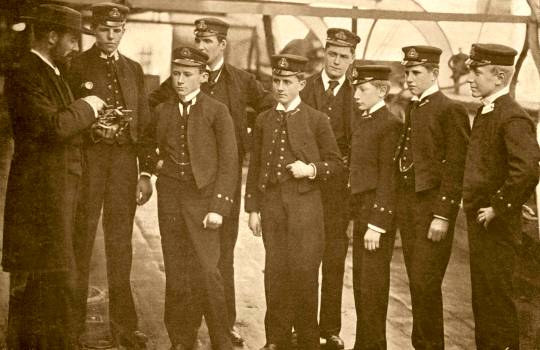
Midshipman on extreme right and cadets receiving sextant instruction on board an HM Ship
The P&O Steam Navigation Company actively encouraged its young deck officer cadets to join the RNR, where they were 'appointed' Midshipman, as flying the Blue Ensign added to the prestige in which the company was held, by the general public, and its passengers.
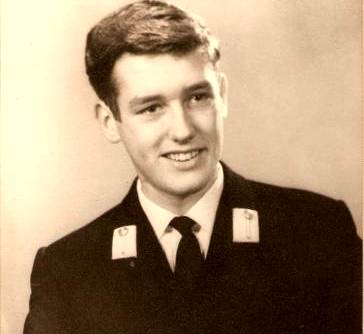
Midshipman Nicholas Messinger RNR, 1961
During both World Wars, many of the Company's cadets were 'called up' - serving in major warships and armed merchant cruisers. On passing for Second Mate, Cadets holding the rank of Midshipmen were commissioned as Probationary Acting Sub Lieutenants, and on completion of 6 months continuous - P Course - training with the Royal Navy, were confirmed as Sub Lieutenants RNR. During the two World Wars, many P&O Officers served with great distinction in HM ships, some rising to the rank of Captain, and in some cases, Commodore, the highest rank achievable by Officers of the Royal Naval Reserve.

RNR Midshipman's Dirk & Scabbard
A Remarkably Brave P& O Officer Cadet
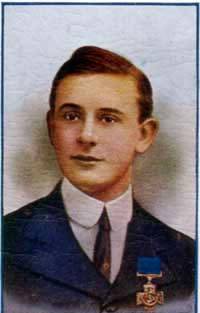
Midshipman George Leslie Drewry VC, Royal Naval Reserve, was born in 1894, at Forest Gate, London. He joined the Mercantile Marine after leaving Merchant Taylors School, Blackheath; early during his service he was shipwrecked, and spent 14 days on a desert island, living on edible roots and shell-fish. He joined the P. & O. as an officer cadet in 1912 and in the following year entered the Royal Naval Reserve. Called up for active service in August 1914, he was appointed Midshipman aboard H.M.S. Hussar. He was awarded the Victoria Cross - the first R.N.R./Merchant Navy award - for his outstanding gallantry in the famous landings from the S.S. River Clyde on the Gallipoli Peninsula on 25 April 1915. The converted Collier, with over 2,000 troops on board grounded at V Beach, Cape Helles, at 6.10 a.m.; the lighters which were to form a bridge to the beach failed to position correctly, leaving a gap between them. Unable to cross, some men jumped into the sea and attempted to wade to the beach but many were cut down by the murderous rifle, pom-pom and machine-gun fire from the Turkish shore positions. Those who reached the beach, struggled through masses of barbed wire and other obstacles. Midshipman Drewry assisted Commander Unwin and Seaman Williams in securing the boats in an attempt to bridge the gap. Although wounded in the head, Drewry continued his work and twice subsequently attempted to swim from lighter to lighter with a line. Five naval Victoria Crosses were awarded for this operation. Tragically, in 1918, Lieutenant Drewry VC, RNR, while in command of H.M.T. William Jackson, on the Northern Patrol, was fatally injured on 2nd August, when a heavy block from the head of a derrick fell on his head. A stained glass window was erected to his memory in All Saints Church, Forest Gate.
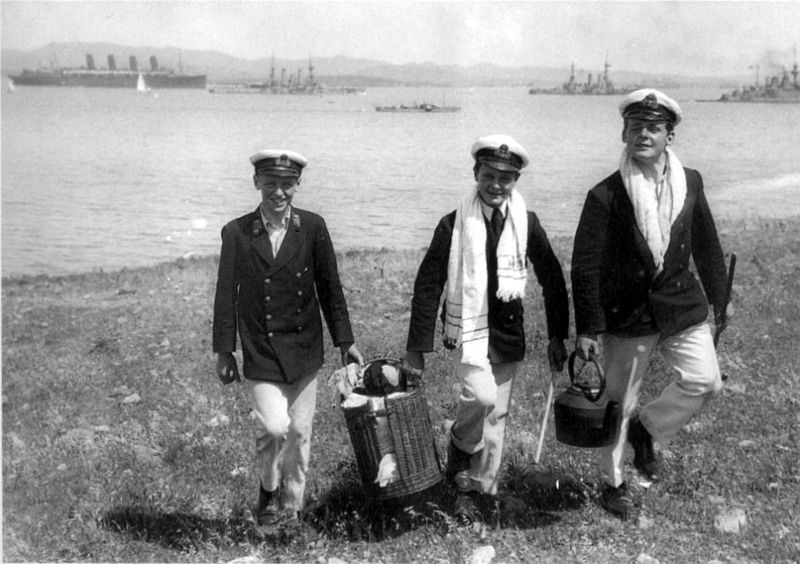
Three Royal Navy midshipmen, George Drewry, Wilfred Malleson and Greg Russell, having a picnic on Imbros during the Galipolli campaign.
Drewry and Malleson had just been awarded the Victoria Cross during the landing at V Beach, Cape Helles, on 25 April 1915.
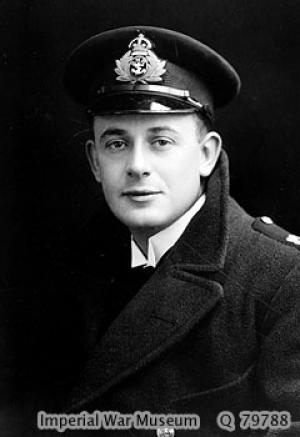

Royal Navy officer's 'sword of honour' and scabbard as presented to Sub-Lieutenant George Leslie DrewryVC, RNR, on 1 December 1916, by the Imperial Merchant Service Guild in acknowledgment of him being the first Royal Naval Reserve Officer to win the Victoria Cross for his bravery as a Midshipman during the initial landings at Gallipoli, at 'V' Beach on 25 April 1915. (See The Supplement to the London Gazette, dated 16 August 1915, issue 29264, page 8132).
For more information on this remarkable young man, please click the link above.